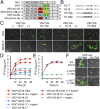Synthetically derived bat influenza A-like viruses reveal a cell type- but not species-specific tropism
- PMID: 27791106
- PMCID: PMC5111703
- DOI: 10.1073/pnas.1608821113
Synthetically derived bat influenza A-like viruses reveal a cell type- but not species-specific tropism
Abstract
Two novel influenza A-like viral genome sequences have recently been identified in Central and South American fruit bats and provisionally designated "HL17NL10" and "HL18NL11." All efforts to isolate infectious virus from bats or to generate these viruses by reverse genetics have failed to date. Recombinant vesicular stomatitis virus (VSV) encoding the hemagglutinin-like envelope glycoproteins HL17 or HL18 in place of the VSV glycoprotein were generated to identify cell lines that are susceptible to bat influenza A-like virus entry. More than 30 cell lines derived from various species were screened but only a few cell lines were found to be susceptible, including Madin-Darby canine kidney type II (MDCK II) cells. The identification of cell lines susceptible to VSV chimeras allowed us to recover recombinant HL17NL10 and HL18NL11 viruses from synthetic DNA. Both influenza A-like viruses established a productive infection in MDCK II cells; however, HL18NL11 replicated more efficiently than HL17NL10 in this cell line. Unlike conventional influenza A viruses, bat influenza A-like viruses started the infection preferentially at the basolateral membrane of polarized MDCK II cells; however, similar to conventional influenza A viruses, bat influenza A-like viruses were released primarily from the apical site. The ability of HL18NL11 or HL17NL10 viruses to infect canine and human cells might reflect a zoonotic potential of these recently identified bat viruses.
Keywords: bat; chiroptera; emerging viruses; influenza; orthomyxoviridae.
Conflict of interest statement
The authors declare no conflict of interest.
Figures









Similar articles
-
Specific Mutations in the PB2 Protein of Influenza A Virus Compensate for the Lack of Efficient Interferon Antagonism of the NS1 Protein of Bat Influenza A-Like Viruses.J Virol. 2018 Mar 14;92(7):e02021-17. doi: 10.1128/JVI.02021-17. Print 2018 Apr 1. J Virol. 2018. PMID: 29321309 Free PMC article.
-
Bat lung epithelial cells show greater host species-specific innate resistance than MDCK cells to human and avian influenza viruses.Virol J. 2018 Apr 10;15(1):68. doi: 10.1186/s12985-018-0979-6. Virol J. 2018. PMID: 29636078 Free PMC article.
-
Unexpected Functional Divergence of Bat Influenza Virus NS1 Proteins.J Virol. 2018 Feb 12;92(5):e02097-17. doi: 10.1128/JVI.02097-17. Print 2018 Mar 1. J Virol. 2018. PMID: 29237829 Free PMC article.
-
Chiropteran influenza viruses: flu from bats or a relic from the past?Curr Opin Virol. 2016 Feb;16:114-119. doi: 10.1016/j.coviro.2016.02.003. Epub 2016 Mar 3. Curr Opin Virol. 2016. PMID: 26947779 Review.
-
Inferring the Urban Transmission Potential of Bat Influenza Viruses.Front Cell Infect Microbiol. 2020 Jun 3;10:264. doi: 10.3389/fcimb.2020.00264. eCollection 2020. Front Cell Infect Microbiol. 2020. PMID: 32582567 Free PMC article. Review.
Cited by
-
Identification of two residues within the NS1 of H7N9 influenza A virus that critically affect the protein stability and function.Vet Res. 2018 Oct 1;49(1):98. doi: 10.1186/s13567-018-0594-y. Vet Res. 2018. PMID: 30285871 Free PMC article.
-
Bats reveal the true power of influenza A virus adaptability.PLoS Pathog. 2020 Apr 16;16(4):e1008384. doi: 10.1371/journal.ppat.1008384. eCollection 2020 Apr. PLoS Pathog. 2020. PMID: 32298389 Free PMC article. No abstract available.
-
Breaking the Convention: Sialoglycan Variants, Coreceptors, and Alternative Receptors for Influenza A Virus Entry.J Virol. 2020 Jan 31;94(4):e01357-19. doi: 10.1128/JVI.01357-19. Print 2020 Jan 31. J Virol. 2020. PMID: 31776280 Free PMC article. Review.
-
Influenza.Nat Rev Dis Primers. 2018 Jun 28;4(1):3. doi: 10.1038/s41572-018-0002-y. Nat Rev Dis Primers. 2018. PMID: 29955068 Free PMC article. Review.
-
Mutations in the Neuraminidase-Like Protein of Bat Influenza H18N11 Virus Enhance Virus Replication in Mammalian Cells, Mice, and Ferrets.J Virol. 2020 Feb 14;94(5):e01416-19. doi: 10.1128/JVI.01416-19. Print 2020 Feb 14. J Virol. 2020. PMID: 31801857 Free PMC article.
References
Grants and funding
LinkOut - more resources
Full Text Sources
Other Literature Sources

